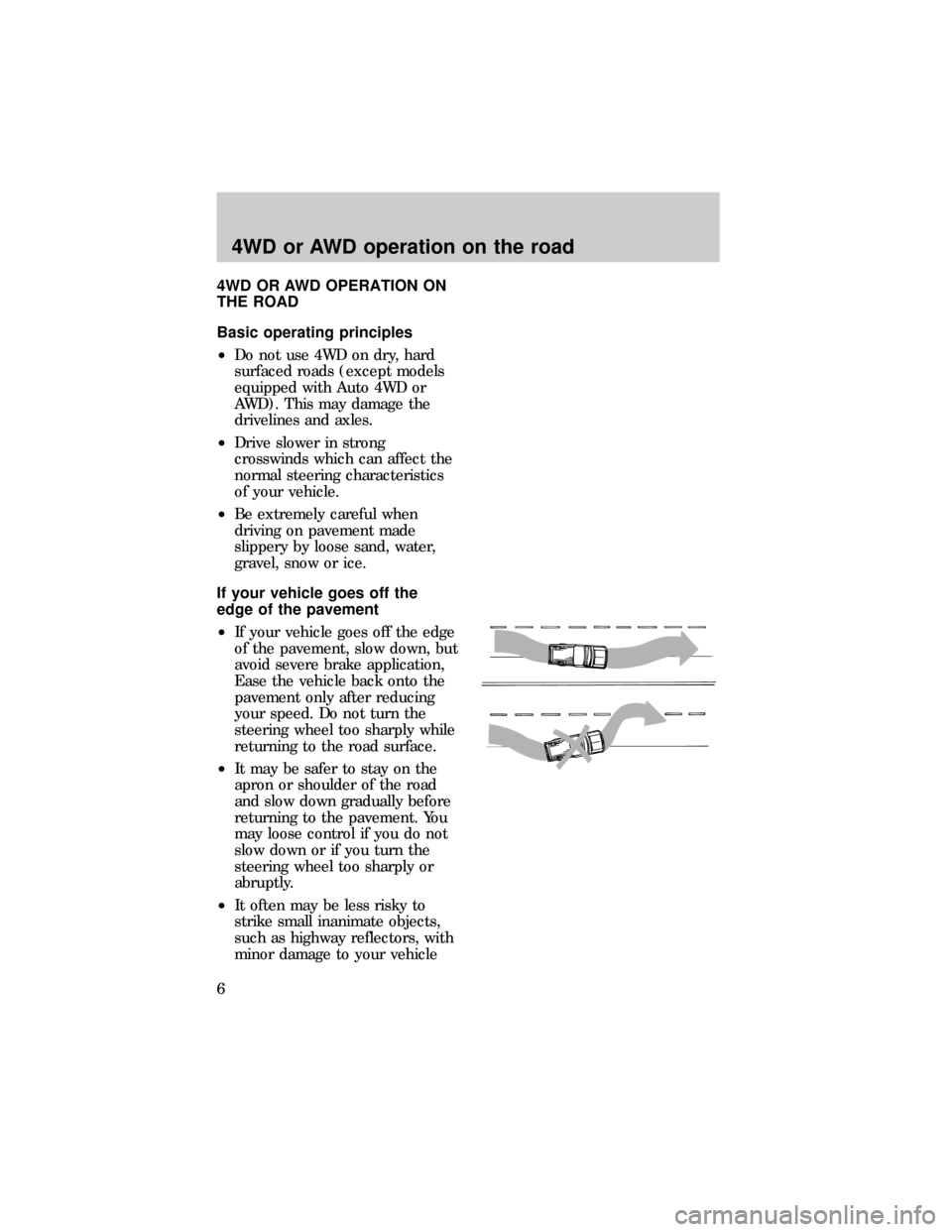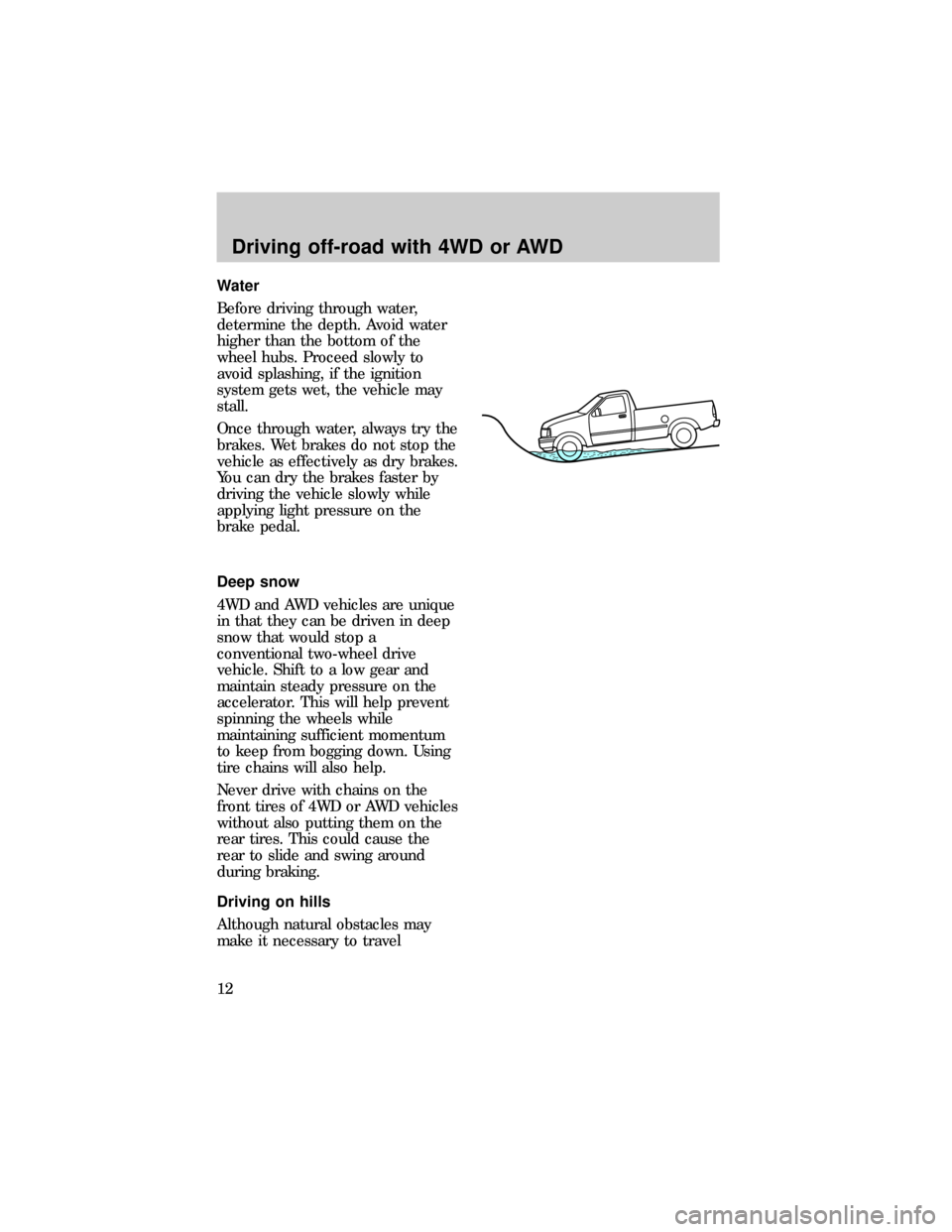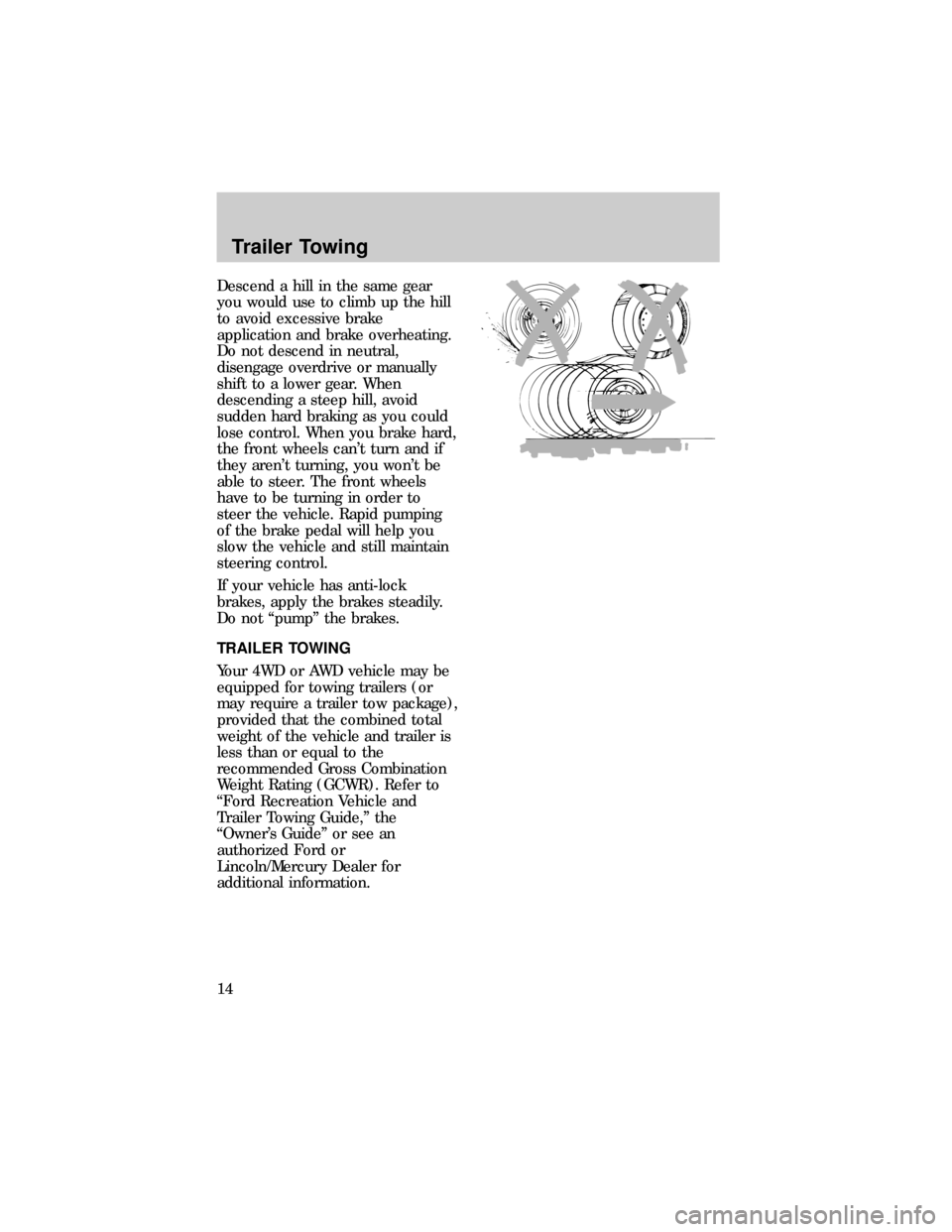brake FORD RANGER 1999 2.G 4x4 Supplement Manual
[x] Cancel search | Manufacturer: FORD, Model Year: 1999, Model line: RANGER, Model: FORD RANGER 1999 2.GPages: 20, PDF Size: 0.22 MB
Page 6 of 20

4WD OR AWD OPERATION ON
THE ROAD
Basic operating principles
²Do not use 4WD on dry, hard
surfaced roads (except models
equipped with Auto 4WD or
AWD). This may damage the
drivelines and axles.
²Drive slower in strong
crosswinds which can affect the
normal steering characteristics
of your vehicle.
²Be extremely careful when
driving on pavement made
slippery by loose sand, water,
gravel, snow or ice.
If your vehicle goes off the
edge of the pavement
²If your vehicle goes off the edge
of the pavement, slow down, but
avoid severe brake application,
Ease the vehicle back onto the
pavement only after reducing
your speed. Do not turn the
steering wheel too sharply while
returning to the road surface.
²It may be safer to stay on the
apron or shoulder of the road
and slow down gradually before
returning to the pavement. You
may loose control if you do not
slow down or if you turn the
steering wheel too sharply or
abruptly.
²It often may be less risky to
strike small inanimate objects,
such as highway reflectors, with
minor damage to your vehicle
4WD or AWD operation on the road
6
Page 7 of 20

rather than attempt a sudden
return to the pavement which
could cause the vehicle to slide
sideways out of control or
rollover. Remember, your safety
and the safety of others should
be your primary concern.
Emergency maneuvers
²In an unavoidable emergency
situation where a sudden sharp
turn must be made, remember
to avoid ªover-drivingº your
vehicle, i.e., turn the steering
wheel only as rapidly and as far
as required to avoid the
emergency. Excessive steering
will result in less vehicle control,
not more. Additionally, smooth
variations of the accelerator
and/or brake pedal pressure
should be utilized if changes in
vehicle speed are called for.
Avoid abrupt steering,
acceleration or braking. Use all
available road surface to return
the vehicle to a safe direction of
travel.
²In the event of an emergency
stop, avoid skidding the tires
and do not attempt any sharp
steering wheel movements.
²If the vehicle goes from one
type of surface to another (i.e.,
from concrete to gravel) there
will be a change in the way the
vehicle responds to a maneuver
(steering, acceleration or
barking). Again, avoid these
abrupt inputs.
4WD or AWD operation on the road
7
Page 8 of 20

Snow and ice
Your 4WD or AWD vehicle will
have advantages over two-wheel
drive vehicles in snow and on ice
by providing increased driving
traction. However, if you suddenly
change speed or direction you may
lose control. 4WD and AWD
vehicles can slide on slippery roads
just like any other vehicle. Should
you start to slide while driving on
snowy or icy roads, turn the
steering wheel in the direction of
the slide until you regain control.
Avoid sudden braking as well.
Although a 4WD or AWD vehicle
may accelerate better than a
two-wheel drive vehicle in snow
and ice, it won't stop any faster,
because as in other vehicles,
braking occurs at all four wheels.
Do not become overconfident as to
road conditions.
Make sure you allow sufficient
distance between you and other
vehicles for stopping. In
emergency stopping situations,
avoid locking of the wheels. Use a
ªsqueezeº technique, push on the
brake pedal with a steadily
increasing force which allows the
wheels to brake yet continue to
roll so that you may steer in the
direction you want to travel. If you
lock the wheels, release the brake
pedal and repeat the squeeze
technique. If your vehicle has
anti-lock brakes, apply the brake
steadily. Do not ªpumpº the
brakes. See your ªOwner's Guideº
for additional information on the
4WD or AWD operation on the road
8
Page 9 of 20

operation of the anti-lock brake
system.
Parking
Before leaving the driver's seat,
you should make sure that the
gearshift is engaged in P (Park)
with an automatic transmission or
either 1 (First) or R (Reverse)
with a manual transmission. Set
the parking brake fully, shut off
the ignition and remove the key.
On some 4WD vehicles, when the
transfer case is in the N (Neutral)
position, the engine and
transmission are disconnected
from the rest of the driveline.
Therefore, the vehicle is free to
roll even if the automatic
transmission is in P (Park) or the
manual transmission is in gear. Do
not leave the vehicle unattended
with the transfer case in N
(Neutral) position. Always set the
parking brake fully and turn off the
ignition when leaving the vehicle.
DRIVING OFF-ROAD WITH 4WD
OR AWD
When using 4WD or AWD,
maintain steering wheel control at
all times, especially in rough
terrain. Since sudden changes in
terrain can result in abrupt
steering wheel motion, make sure
you grip the steering wheel from
the outside. Do not grip the
spokes.
Driving off-road with 4WD or AWD
9
Page 12 of 20

Water
Before driving through water,
determine the depth. Avoid water
higher than the bottom of the
wheel hubs. Proceed slowly to
avoid splashing, if the ignition
system gets wet, the vehicle may
stall.
Once through water, always try the
brakes. Wet brakes do not stop the
vehicle as effectively as dry brakes.
You can dry the brakes faster by
driving the vehicle slowly while
applying light pressure on the
brake pedal.
Deep snow
4WD and AWD vehicles are unique
in that they can be driven in deep
snow that would stop a
conventional two-wheel drive
vehicle. Shift to a low gear and
maintain steady pressure on the
accelerator. This will help prevent
spinning the wheels while
maintaining sufficient momentum
to keep from bogging down. Using
tire chains will also help.
Never drive with chains on the
front tires of 4WD or AWD vehicles
without also putting them on the
rear tires. This could cause the
rear to slide and swing around
during braking.
Driving on hills
Although natural obstacles may
make it necessary to travel
Driving off-road with 4WD or AWD
12
Page 14 of 20

Descend a hill in the same gear
you would use to climb up the hill
to avoid excessive brake
application and brake overheating.
Do not descend in neutral,
disengage overdrive or manually
shift to a lower gear. When
descending a steep hill, avoid
sudden hard braking as you could
lose control. When you brake hard,
the front wheels can't turn and if
they aren't turning, you won't be
able to steer. The front wheels
have to be turning in order to
steer the vehicle. Rapid pumping
of the brake pedal will help you
slow the vehicle and still maintain
steering control.
If your vehicle has anti-lock
brakes, apply the brakes steadily.
Do not ªpumpº the brakes.
TRAILER TOWING
Your 4WD or AWD vehicle may be
equipped for towing trailers (or
may require a trailer tow package),
provided that the combined total
weight of the vehicle and trailer is
less than or equal to the
recommended Gross Combination
Weight Rating (GCWR). Refer to
ªFord Recreation Vehicle and
Trailer Towing Guide,º the
ªOwner's Guideº or see an
authorized Ford or
Lincoln/Mercury Dealer for
additional information.
Trailer Towing
14